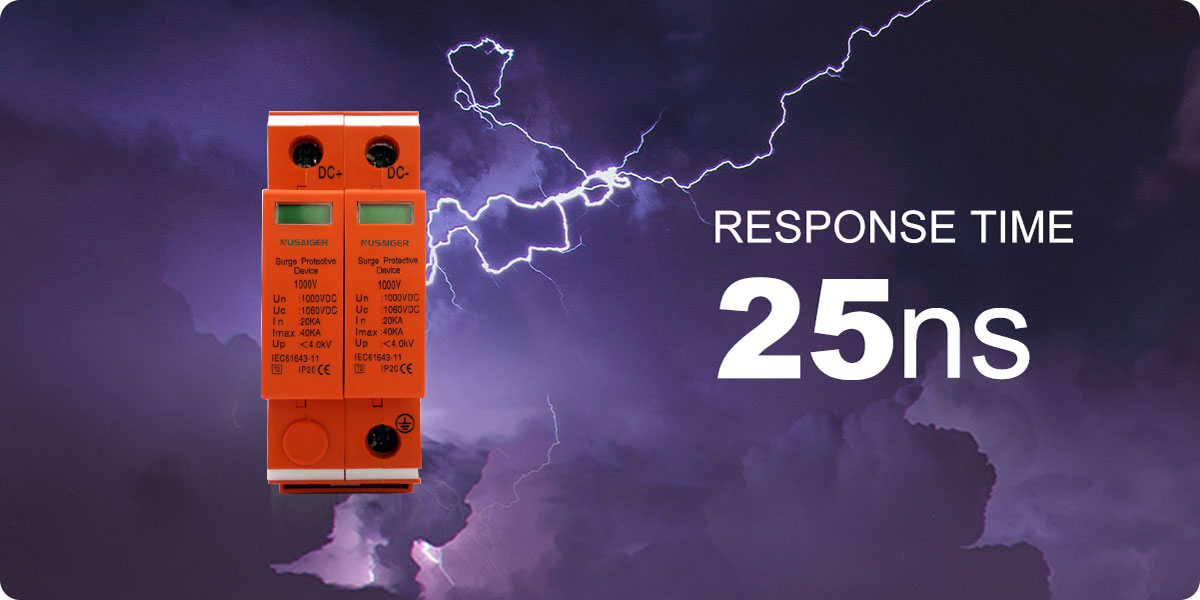Comprehensive Guide to Surge Protective Devices for Solar and Electrical Systems
Surge Protective Devices (SPDs) are critical components for safeguarding solar photovoltaic systems, industrial electrical networks, and residential power installations.
Voltage surges caused by lightning strikes, grid switching, or inductive loads can damage sensitive electronics, shorten equipment lifespan, and even cause fires.
This comprehensive guide will explore everything about SPDs: types, selection criteria, installation practices, maintenance tips, and industry best practices.
1. What is a Surge Protective Device (SPD)?
An SPD is an electrical device designed to limit overvoltage by diverting surge current safely to the ground. It protects electrical and electronic equipment from transient overvoltage events.
SPDs are widely used in residential, commercial, and solar PV applications to ensure continuity, safety, and reliability.
2. Types of Surge Protective Devices
SPDs can be categorized based on voltage levels, application, and design:
- Type 1 SPDs: Installed on the line side of the main service panel; capable of handling high-energy surges from direct lightning strikes.
- Type 2 SPDs: Connected downstream of the main distribution board; protects against indirect surges from utility lines.
- Type 3 SPDs: Installed near sensitive loads; ideal for protecting individual devices.
- DC SPDs: Specialized SPDs for photovoltaic systems to protect the DC circuits of solar panels.
3. How SPDs Work
SPDs operate by diverting excessive voltage away from sensitive components:
- Voltage Clamping: SPDs activate when voltage exceeds a threshold, shunting excess energy to ground.
- Energy Absorption: Components like metal-oxide varistors (MOVs) absorb surge energy.
- Response Time: High-quality SPDs respond in nanoseconds to prevent damage.
4. Importance of SPDs in Solar PV Systems
In solar systems, SPDs protect:
- Inverters, charge controllers, and monitoring devices
- DC combiner boxes and AC distribution boards
- Electrical wiring and sensitive electronics
Lightning-induced surges or grid fluctuations can generate thousands of volts, posing a high risk to PV modules and inverters. Proper SPD selection ensures system longevity and performance.
5. Selecting the Right SPD
Consider the following factors:
- System Voltage: SPD must match the system voltage (AC or DC).
- Maximum Discharge Current (Imax): High Imax SPDs handle stronger surges.
- Response Time: Faster response reduces transient exposure.
- Voltage Protection Level (Up): Ensure it is below equipment tolerance.
- Standards Compliance: IEC 61643, UL 1449, or equivalent certifications.
6. Installation Best Practices
Proper installation is crucial to maximize SPD efficiency:
- Install as close as possible to protected equipment
- Use short, straight, and thick grounding conductors
- Follow manufacturer torque specifications for terminals
- Install upstream fuses or circuit breakers to prevent SPD overcurrent damage
- Separate AC and DC SPDs from sensitive communication lines
7. SPD Maintenance and Inspection
Regular maintenance ensures SPDs remain functional:
- Visual inspection for burnt indicators or MOV damage
- Test SPD status indicators periodically
- Replace SPDs after major lightning events
- Record installation dates and service history
8. Case Study: Solar Farm Protection
A 5MW solar farm in Spain experienced repeated inverter failures due to lightning surges.
By installing Type 1+2 SPDs at combiner boxes and inverter inputs, the farm achieved:
- 90% reduction in equipment downtime
- Elimination of surge-related inverter damage
- Improved energy yield and system reliability
9. Common SPD Misconceptions
- SPDs are not fuses; they do not disconnect the circuit during normal operation.
- All SPDs are not the same; quality and rating matter significantly.
- SPD installation alone does not prevent lightning strikes; grounding and bonding are essential.
10. Emerging Trends in SPD Technology
The SPD market is evolving with:
- Smart SPDs with remote monitoring and alerts
- Integrated surge protection for IoT-enabled electrical networks
- Compact and modular designs for rooftop solar installations
- Improved MOV materials and response times for higher energy absorption
Conclusion
Surge Protective Devices are indispensable for modern electrical and solar systems. Understanding their types, selection,
installation, and maintenance ensures maximum protection against transient overvoltages.
With the rise of smart SPDs, integrating monitoring and IoT capabilities, these devices are becoming more intelligent,
reliable, and essential for system safety and efficiency.



